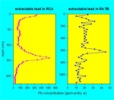Research topics
Humans have dramatically disturbed the earth's N cycle to the point that this alteration is considered one of the most serious threats to the global ecosystem. Part of the excess N circulates through the atmosphere and is deposited with precipitation, reaching areas that would otherwise be free of direct human impact. Atmospherically deposited N has an acidifying effect on aquatic ecosystems, and causes also changes in the pattern of ecological nutrient limitation in lakes. Pyrenean catchments are saturated of N of human origin and streams are leaching that N excess.
Mining and smelting have been a source of lead atmospheric pollution since ancient times. Atmospheric lead may travel long distances before it is deposited on remote ecosystems like alpine lakes. A sediment core retrieved in Lake Redon revealed that lead pollution started here already 2,700 years ago, and peaked in the VII century. Further studies have shown a widespread contamination in sediments from lakes accross the Pyrenees. And moreover, there is a lead legacy stored for centuries in soils that is been leached nowadays causing a delayed pollution to lakes.


